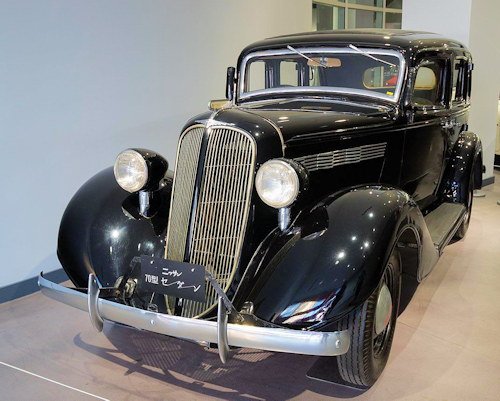Nissan 70
 | |
Production period: | 1938 to 1943 |
Class : | Motor car |
Body versions : | Touring car , limousine |
Engines: | Gasoline :3.7 liters (62.5 kW) |
Length: | 4750 mm |
Width: | 1720 mm |
Height: | 1750 mm |
Wheelbase : | 2794 mm |
Curb weight : | 1410 kg |
The Nissan Type-70 was the first car model from Nissan from the late 1930s.
History
The Type 70 was produced as a four-door sedan and Phaeton starting in August 1937. The Phaeton was a fabric-covered open automobile. The model competed with the Toyoda AA, which had already been released in 1936 and was aimed at the upper middle class in Japan, while the original model in North America was aimed at the lower middle class. Except for Toyota, there were only two competitors: Chevrolet, which had its own assembly plant in Japan, and Ford. With a starting price of $4000 for the standard sedan and $4500 for a taxi model with three rear seats and two additional emergency seats, the Type 70 quickly rose to the top of the market. Furthermore, in 1938, the Phaeton was offered with a lined fabric roof and a folding windshield, which was mainly acquired by the Japanese army.
The gasoline engine was coupled with a 4-speed manual transmission. After the war began, the entire production went to the Japanese army and Nissan also produced a model with ambulance construction. This ensured Nissan good sales, but at the same time was linked to other Nissan war products, the name Nissan with the war in Japan, which is why Nissan began in the 1970s, the brand Nissan to use in export. In 1943, because of scarcity of raw materials in the war, the production of the type 70 ended. The successor in the segment of the upper middle class in the group was built starting from 1948 Datsun DB .
After the founding of Nissan, a new president came to the forefront of Nissan Motor Co., Ltd., Rokuro Auykama. The engineer William Gorham, who emigrated from North America to Japan at the beginning of the 20th century , who had already brought his vehicle brand Lila Automobile into Datsun . Auykama commissioned Gorham to search in the US for a cooperation partner for Nissan, since so far only Datsun small cars and trucks (pickups) were built. In addition, Nissan had a large property in Yokohama.
The company acquired and planned to build a new factory, as all models were previously prefabricated by different suppliers and had to be assembled in the Datsun workshop (the factory had recently been struck by lightning). Gorham found Graham-Paige in financial difficulties in the United States and negotiated a cooperation agreement or license agreement. This provided for the purchase of a complete production facility of the Graham-Paige Crusader and the Graham-Paige Truck (truck), as Graham-Paige was forced to close a plant due to economic difficulties. For the equipment and royalties, Nissan had to pay US $ 390000 to Graham-Paige. After the new factory was built on the site in Yokohama, from 1935 the Datsun 15The integration and preparation of the Graham Paige license production was produced and paralleled. From 1937 the truck Nissan 80 was produced and in the same year started the production of the Nissan type 70. Because of the Second World War the production of the model ended already 1943 after 5500 copies, while the truck, which meanwhile with the Nissan 90 , a minibus was supplemented on the basis of 80, was further produced.
Rating
Technical
-
Nissan 70 Specifications (1938-1943)
Overall length 4,750mm
Overall width 1,720mm
Overall height 1,750mm
Wheelbase 2,794mm
Curb weight 1,410kg
Engine Type A (6-cyl. in line, SV), 3,670cc
Engine Max. power 63kW (85PS)/3,400rpm
Engine Max. torque 226Nm (23kgm)/1,200rpm
Tires 6.00-16-4PR
Seating capacity 5 or 7
Top speed 80km/h



